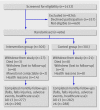Effect on falls of providing single lens distance vision glasses to multifocal glasses wearers: VISIBLE randomised controlled trial
- PMID: 20501583
- PMCID: PMC2876235
- DOI: 10.1136/bmj.c2265
Effect on falls of providing single lens distance vision glasses to multifocal glasses wearers: VISIBLE randomised controlled trial
Erratum in
-
Effect on falls of providing single lens distance vision glasses to multifocal glasses wearers: VISIBLE randomised controlled trial.BMJ. 2016 May 27;353:i3041. doi: 10.1136/bmj.i3041. BMJ. 2016. PMID: 27235404 No abstract available.
Abstract
Objective: To determine whether the provision of single lens distance glasses to older wearers of multifocal glasses reduces falls.
Design: Parallel randomised controlled trial stratified by recruitment site and source of referral, with 13 months' follow-up and outcome assessors blinded to group allocation.
Setting: Community recruitment and treatment room assessments in Sydney and Illawarra regions of NSW, Australia.
Participants: 606 regular wearers of multifocal glasses (mean age 80 (SD 7) years). Inclusion criteria included increased risk of falls (fall in previous year or timed up and go test >15 seconds) and outdoor use of multifocal glasses at least three times a week.
Interventions: Provision of single lens distance glasses with recommendations for wearing them for walking and outdoor activities compared with usual care.
Main outcome measures: Number of falls and injuries resulting from falls during follow-up.
Results: Single lens glasses were provided to 275 (90%) of the 305 intervention group participants within two months; 162 (54%) of the intervention group reported satisfactory use of distance glasses for walking and outdoor activities for at least 7/12 months after dispensing. In the 299 intervention and 298 control participants available to follow-up, the intervention resulted in an 8% reduction in falls (incidence rate ratio 0.92, 95% confidence interval 0.73 to 1.16). Pre-planned sub-group analyses showed that the intervention was effective in significantly reducing all falls (incidence rate ratio 0.60, 0.42 to 0.87), outside falls, and injurious falls in people who regularly took part in outside activities. A significant increase in outside falls occurred in people in the intervention group who took part in little outside activity.
Conclusions: With appropriate counselling, provision of single lens glasses for older wearers of multifocal glasses who take part in regular outdoor activities is an effective falls prevention strategy. The intervention may be harmful, however, in multifocal glasses wearers with low levels of outdoor activity.
Trial registration: Clinical trials NCT00350389.
Trial registration: ClinicalTrials.gov NCT00350855 NCT00350389 NCT00350855.
Conflict of interest statement
Competing interests: The physiological profile assessment (FallScreen) is commercially available through the Prince of Wales Medical Research Institute.
Comment in
-
Poor vision and falls.BMJ. 2010 May 25;340:c2456. doi: 10.1136/bmj.c2456. BMJ. 2010. PMID: 20501584 No abstract available.
References
-
- Donahue SP. Loss of accommodation and presbyopia. In: Yanoff M, Duker JS, eds. Ophthalmology. Mosby, 1999.
-
- Duke Elder S. The practice of refraction. Churchill, 1963.
-
- Tinetti ME. Clinical practice: preventing falls in elderly persons. N Engl J Med 2003;348:42-9. - PubMed
-
- Lord SR, Dayhew J, Howland A. Multifocal glasses impair edge contrast sensitivity and depth perception and increase the risk of falls in older people. J Am Geriatr Soc 2002;50:1760-6. - PubMed
-
- Johnson L, Buckley JG, Harley C, Elliott DB. Use of single-vision eyeglasses improves stepping precision and safety when elderly habitual multifocal wearers negotiate a raised surface. J Am Geriatr Soc 2008;56:178-80. - PubMed
Publication types
MeSH terms
Associated data
LinkOut - more resources
Full Text Sources
Medical
Molecular Biology Databases

